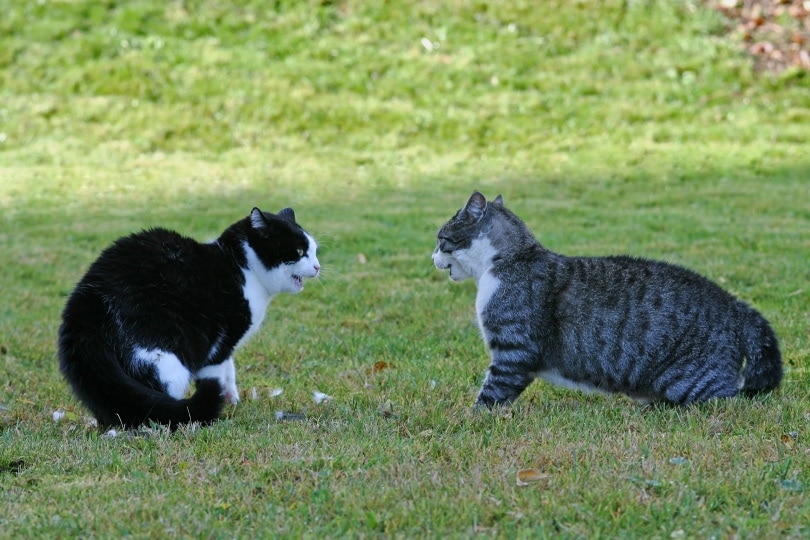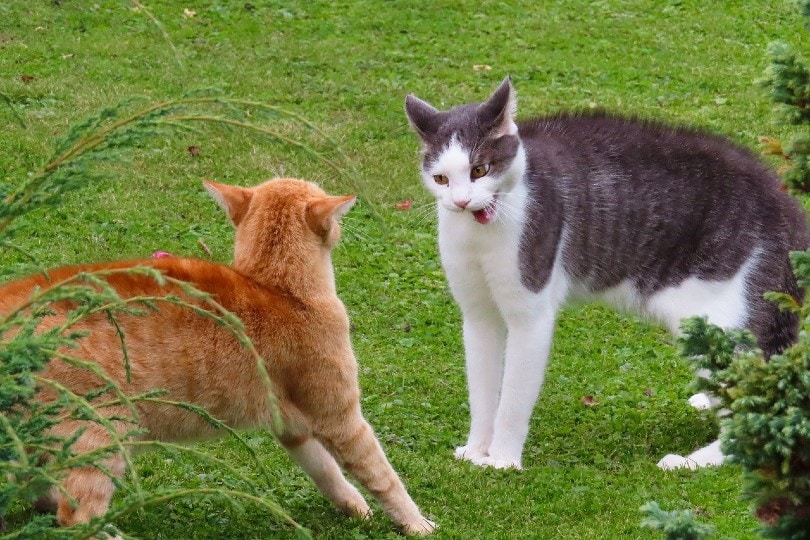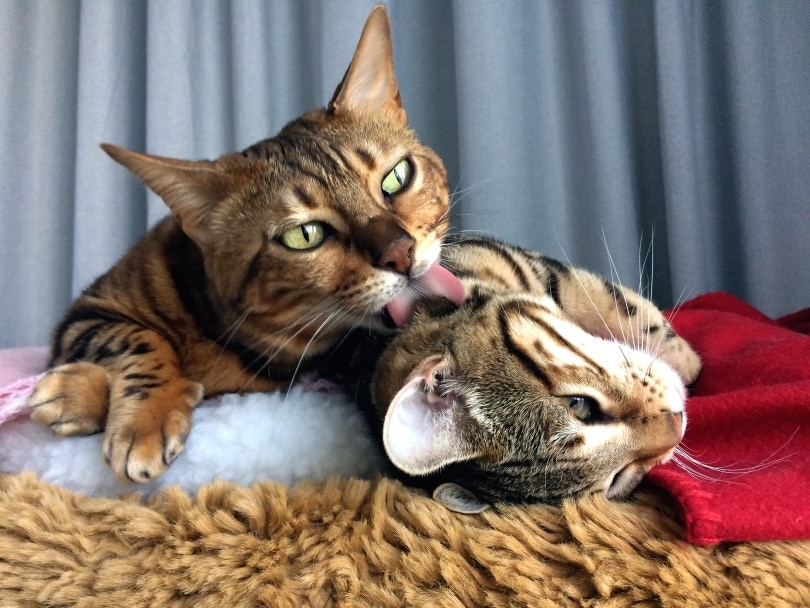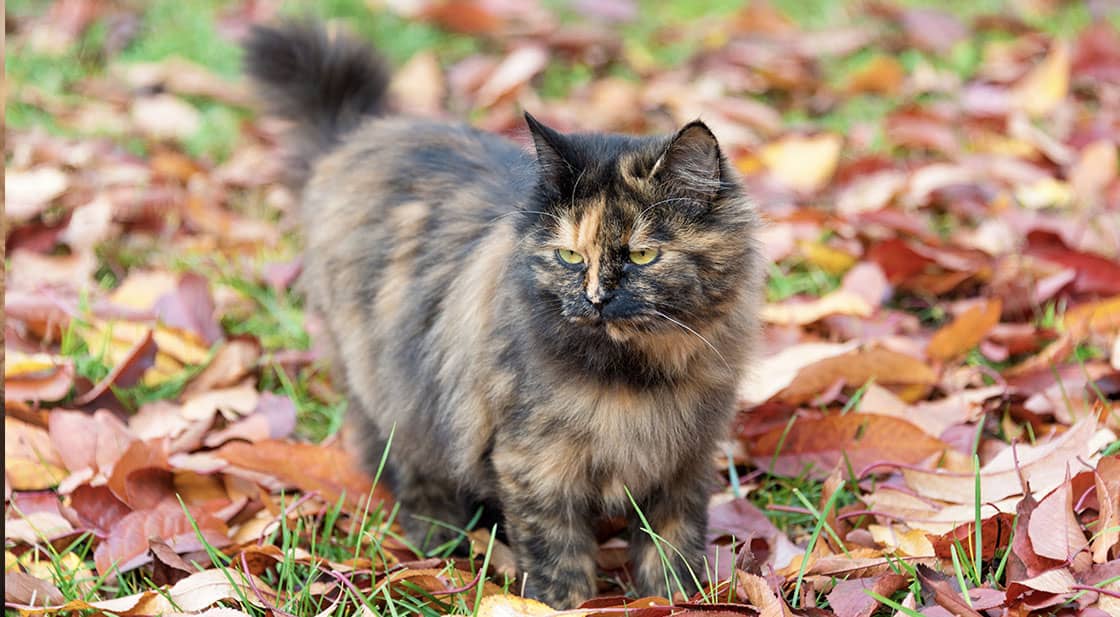Are My Cats Fighting or Just Playing? Feline Aggression Examined

Updated on

Have you ever looked at your cats playing together and wondered if they really were just playing or if things had progressed to something more serious, like a real fight?
You’re not alone. Tons of people struggle to tell the difference, and until you take the time to get to know how cats express themselves and how to tell how they’re feeling, it can be difficult to tell the two activities apart.
We give you a quick rundown to put you on the right track here.
Why Do Cats Play Fight?
In the wild, cats pounce and bat at their prey and to fend off potential predators or mating opponents. Domestic cats still have these instincts, even if they stay safely indoors all the time. They want to keep their skills sharp, so they will “fight” with any other cats in the house. Ideally, the other cat will have the same desire and will reciprocate appropriately.
Sometimes, however, a cat may feel that their “territory” in the house is being infringed upon by other cats and will fight seriously to maintain their boundaries.
How Do I Know If My Cats Are Fighting or Playing?
The last thing that you want is to assume that your cats are just playing together when it turns out that they’re in the middle of an actual scuffle.
Before going over the individual signs, we have to reiterate that the best thing that you can do is to get to know your cats. Each cat will have their own personality, so while these tips are a great starting point, some cats simply don’t fit into traditional molds.

Signs That Your Cats Are Fighting
If you know what you’re looking for, it’s not too hard to tell when your cats have crossed the line and aren’t play fighting anymore.
Look for puffed tails, flat and pinned-back ears, or puffed-up fur throughout their body. If any of these signs are present, your cats aren’t playing anymore — they’re looking for a way to take out their actual aggression.
Claws should also remain firmly retracted, as cats typically only pull out their claws when they’re trying to fight for real. Any of these signs are huge red flags, and you might need to intervene before things get out of hand.
Just be careful because cat claws can hurt you just as easily as another cat.
Signs That Your Cats Are Playing
Many cats play in an ”aggressive” manner. They’re not actually fighting, but if you don’t know the warning signs, it can be hard to tell the difference. If you’re paying attention, you might be able to notice a few tell-tale signs that they’re just playing.
A common sign is that they take turns. You’ll notice that one cat doesn’t stay on top all the time, and they’ll swap to give each other a turn. They’ll often chase each other, pounce on each other, and play-bite during this time.
They’ll often take breaks, and this is all completely normal. Take a look at their fur to see if it’s still lying flat and at their tails to ensure that they’re not puffed up. If the tail has a slight curl to it, that’s even better. They should remain relaxed with their ears pointed forward.
It’s cat body language 101, with signs that everything is going the way that it should.
Signs That Your Cats Like Each Other

Maybe you’re looking for a sign that your cats actually like each other when they’re not playing, and that’s a perfectly normal thing to wonder about. One of the best ways to tell is by how much your cats hang out together.
While they don’t have to spend every waking moment with each other, cats that like each other tend to spend time together. Common behaviors include:
- Napping together
- Nuzzling each other
- Grooming each other
- Hanging out together
- Playing together
If your cats are doing any of these things together, chances are they enjoy each other’s company!
Conclusion
Not every cat reacts the same way to the same event, so just because one cat is in the mood to play doesn’t mean the other cat will be. Sometimes, one cat just needs to tell the other one to knock it off, and that happens all the time too.
It’s nothing to worry about as long as it doesn’t happen too often, but it’s a great starting point to help you tell when one cat has had enough and when you might need to intervene.
See also:
- My Cats Used to Get Along But Now They Fight (Here’s Why)
- Why Do Cats Fight? 4 Main Reasons & How to Prevent It
Featured Image Credit: Astrid Gast, Shutterstock











